Yashar Mehdad
Attention or Convolution: Transformer Encoders in Audio Language Models for Inference Efficiency
Nov 05, 2023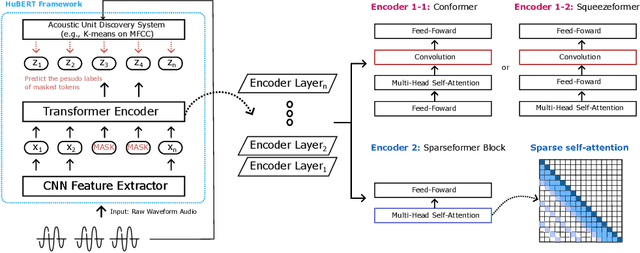


Abstract:In this paper, we show that a simple self-supervised pre-trained audio model can achieve comparable inference efficiency to more complicated pre-trained models with speech transformer encoders. These speech transformers rely on mixing convolutional modules with self-attention modules. They achieve state-of-the-art performance on ASR with top efficiency. We first show that employing these speech transformers as an encoder significantly improves the efficiency of pre-trained audio models as well. However, our study shows that we can achieve comparable efficiency with advanced self-attention solely. We demonstrate that this simpler approach is particularly beneficial with a low-bit weight quantization technique of a neural network to improve efficiency. We hypothesize that it prevents propagating the errors between different quantized modules compared to recent speech transformers mixing quantized convolution and the quantized self-attention modules.
Effective Long-Context Scaling of Foundation Models
Sep 27, 2023



Abstract:We present a series of long-context LLMs that support effective context windows of up to 32,768 tokens. Our model series are built through continual pretraining from Llama 2 with longer training sequences and on a dataset where long texts are upsampled. We perform extensive evaluation on language modeling, synthetic context probing tasks, and a wide range of research benchmarks. On research benchmarks, our models achieve consistent improvements on most regular tasks and significant improvements on long-context tasks over Llama 2. Notably, with a cost-effective instruction tuning procedure that does not require human-annotated long instruction data, the 70B variant can already surpass gpt-3.5-turbo-16k's overall performance on a suite of long-context tasks. Alongside these results, we provide an in-depth analysis on the individual components of our method. We delve into Llama's position encodings and discuss its limitation in modeling long dependencies. We also examine the impact of various design choices in the pretraining process, including the data mix and the training curriculum of sequence lengths -- our ablation experiments suggest that having abundant long texts in the pretrain dataset is not the key to achieving strong performance, and we empirically verify that long context continual pretraining is more efficient and similarly effective compared to pretraining from scratch with long sequences.
LLM-QAT: Data-Free Quantization Aware Training for Large Language Models
May 29, 2023



Abstract:Several post-training quantization methods have been applied to large language models (LLMs), and have been shown to perform well down to 8-bits. We find that these methods break down at lower bit precision, and investigate quantization aware training for LLMs (LLM-QAT) to push quantization levels even further. We propose a data-free distillation method that leverages generations produced by the pre-trained model, which better preserves the original output distribution and allows quantizing any generative model independent of its training data, similar to post-training quantization methods. In addition to quantizing weights and activations, we also quantize the KV cache, which is critical for increasing throughput and support long sequence dependencies at current model sizes. We experiment with LLaMA models of sizes 7B, 13B, and 30B, at quantization levels down to 4-bits. We observe large improvements over training-free methods, especially in the low-bit settings.
VideoOFA: Two-Stage Pre-Training for Video-to-Text Generation
May 04, 2023Abstract:We propose a new two-stage pre-training framework for video-to-text generation tasks such as video captioning and video question answering: A generative encoder-decoder model is first jointly pre-trained on massive image-text data to learn fundamental vision-language concepts, and then adapted to video data in an intermediate video-text pre-training stage to learn video-specific skills such as spatio-temporal reasoning. As a result, our VideoOFA model achieves new state-of-the-art performance on four Video Captioning benchmarks, beating prior art by an average of 9.7 points in CIDEr score. It also outperforms existing models on two open-ended Video Question Answering datasets, showcasing its generalization capability as a universal video-to-text model.
How to Train Your DRAGON: Diverse Augmentation Towards Generalizable Dense Retrieval
Feb 15, 2023Abstract:Various techniques have been developed in recent years to improve dense retrieval (DR), such as unsupervised contrastive learning and pseudo-query generation. Existing DRs, however, often suffer from effectiveness tradeoffs between supervised and zero-shot retrieval, which some argue was due to the limited model capacity. We contradict this hypothesis and show that a generalizable DR can be trained to achieve high accuracy in both supervised and zero-shot retrieval without increasing model size. In particular, we systematically examine the contrastive learning of DRs, under the framework of Data Augmentation (DA). Our study shows that common DA practices such as query augmentation with generative models and pseudo-relevance label creation using a cross-encoder, are often inefficient and sub-optimal. We hence propose a new DA approach with diverse queries and sources of supervision to progressively train a generalizable DR. As a result, DRAGON, our dense retriever trained with diverse augmentation, is the first BERT-base-sized DR to achieve state-of-the-art effectiveness in both supervised and zero-shot evaluations and even competes with models using more complex late interaction (ColBERTv2 and SPLADE++).
STRUDEL: Structured Dialogue Summarization for Dialogue Comprehension
Dec 24, 2022



Abstract:Abstractive dialogue summarization has long been viewed as an important standalone task in natural language processing, but no previous work has explored the possibility of whether abstractive dialogue summarization can also be used as a means to boost an NLP system's performance on other important dialogue comprehension tasks. In this paper, we propose a novel type of dialogue summarization task - STRUctured DiaLoguE Summarization - that can help pre-trained language models to better understand dialogues and improve their performance on important dialogue comprehension tasks. We further collect human annotations of STRUDEL summaries over 400 dialogues and introduce a new STRUDEL dialogue comprehension modeling framework that integrates STRUDEL into a graph-neural-network-based dialogue reasoning module over transformer encoder language models to improve their dialogue comprehension abilities. In our empirical experiments on two important downstream dialogue comprehension tasks - dialogue question answering and dialogue response prediction - we show that our STRUDEL dialogue comprehension model can significantly improve the dialogue comprehension performance of transformer encoder language models.
Improving Faithfulness of Abstractive Summarization by Controlling Confounding Effect of Irrelevant Sentences
Dec 19, 2022



Abstract:Lack of factual correctness is an issue that still plagues state-of-the-art summarization systems despite their impressive progress on generating seemingly fluent summaries. In this paper, we show that factual inconsistency can be caused by irrelevant parts of the input text, which act as confounders. To that end, we leverage information-theoretic measures of causal effects to quantify the amount of confounding and precisely quantify how they affect the summarization performance. Based on insights derived from our theoretical results, we design a simple multi-task model to control such confounding by leveraging human-annotated relevant sentences when available. Crucially, we give a principled characterization of data distributions where such confounding can be large thereby necessitating the use of human annotated relevant sentences to generate factual summaries. Our approach improves faithfulness scores by 20\% over strong baselines on AnswerSumm \citep{fabbri2021answersumm}, a conversation summarization dataset where lack of faithfulness is a significant issue due to the subjective nature of the task. Our best method achieves the highest faithfulness score while also achieving state-of-the-art results on standard metrics like ROUGE and METEOR. We corroborate these improvements through human evaluation.
CITADEL: Conditional Token Interaction via Dynamic Lexical Routing for Efficient and Effective Multi-Vector Retrieval
Nov 18, 2022Abstract:Multi-vector retrieval methods combine the merits of sparse (e.g. BM25) and dense (e.g. DPR) retrievers and have achieved state-of-the-art performance on various retrieval tasks. These methods, however, are orders of magnitude slower and need much more space to store their indices compared to their single-vector counterparts. In this paper, we unify different multi-vector retrieval models from a token routing viewpoint and propose conditional token interaction via dynamic lexical routing, namely CITADEL, for efficient and effective multi-vector retrieval. CITADEL learns to route different token vectors to the predicted lexical ``keys'' such that a query token vector only interacts with document token vectors routed to the same key. This design significantly reduces the computation cost while maintaining high accuracy. Notably, CITADEL achieves the same or slightly better performance than the previous state of the art, ColBERT-v2, on both in-domain (MS MARCO) and out-of-domain (BEIR) evaluations, while being nearly 40 times faster. Code and data are available at https://github.com/facebookresearch/dpr-scale.
Bridging the Training-Inference Gap for Dense Phrase Retrieval
Oct 25, 2022Abstract:Building dense retrievers requires a series of standard procedures, including training and validating neural models and creating indexes for efficient search. However, these procedures are often misaligned in that training objectives do not exactly reflect the retrieval scenario at inference time. In this paper, we explore how the gap between training and inference in dense retrieval can be reduced, focusing on dense phrase retrieval (Lee et al., 2021) where billions of representations are indexed at inference. Since validating every dense retriever with a large-scale index is practically infeasible, we propose an efficient way of validating dense retrievers using a small subset of the entire corpus. This allows us to validate various training strategies including unifying contrastive loss terms and using hard negatives for phrase retrieval, which largely reduces the training-inference discrepancy. As a result, we improve top-1 phrase retrieval accuracy by 2~3 points and top-20 passage retrieval accuracy by 2~4 points for open-domain question answering. Our work urges modeling dense retrievers with careful consideration of training and inference via efficient validation while advancing phrase retrieval as a general solution for dense retrieval.
Structured Summarization: Unified Text Segmentation and Segment Labeling as a Generation Task
Sep 28, 2022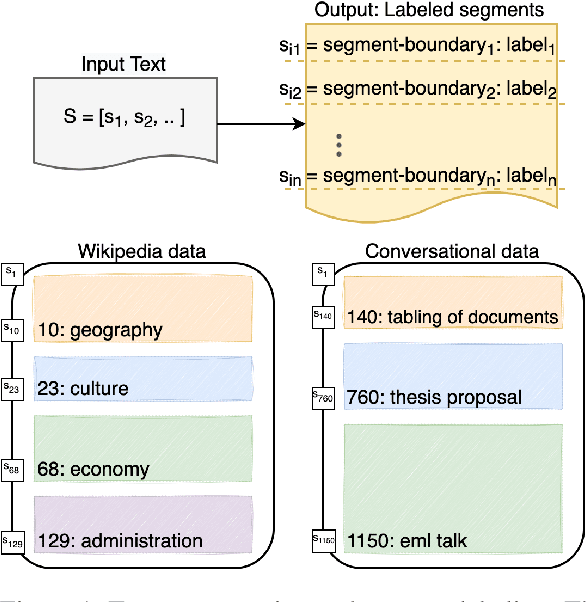
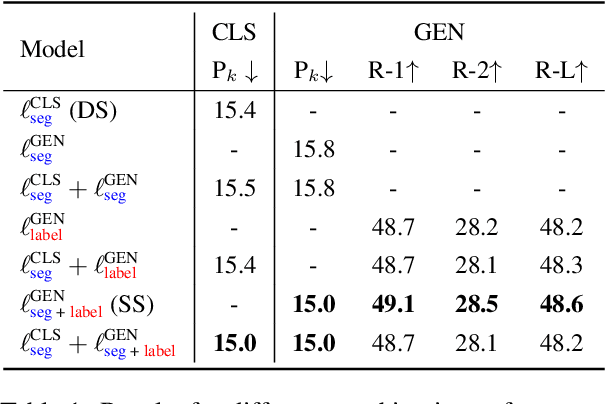
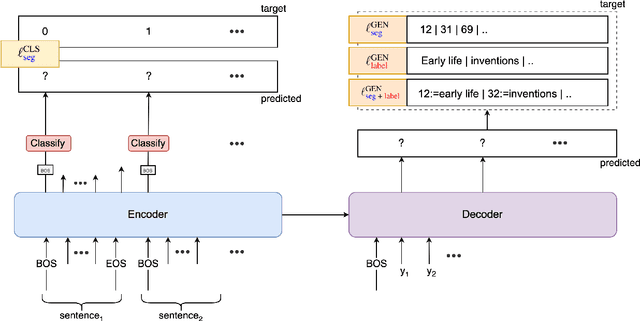
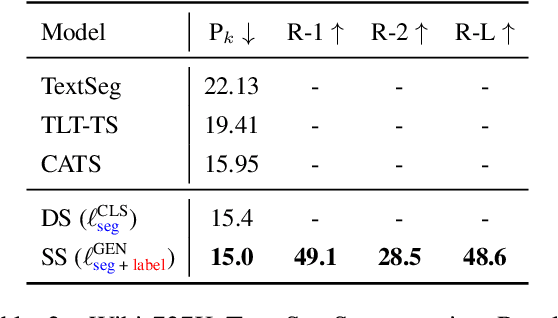
Abstract:Text segmentation aims to divide text into contiguous, semantically coherent segments, while segment labeling deals with producing labels for each segment. Past work has shown success in tackling segmentation and labeling for documents and conversations. This has been possible with a combination of task-specific pipelines, supervised and unsupervised learning objectives. In this work, we propose a single encoder-decoder neural network that can handle long documents and conversations, trained simultaneously for both segmentation and segment labeling using only standard supervision. We successfully show a way to solve the combined task as a pure generation task, which we refer to as structured summarization. We apply the same technique to both document and conversational data, and we show state of the art performance across datasets for both segmentation and labeling, under both high- and low-resource settings. Our results establish a strong case for considering text segmentation and segment labeling as a whole, and moving towards general-purpose techniques that don't depend on domain expertise or task-specific components.
 Add to Chrome
Add to Chrome Add to Firefox
Add to Firefox Add to Edge
Add to Edge